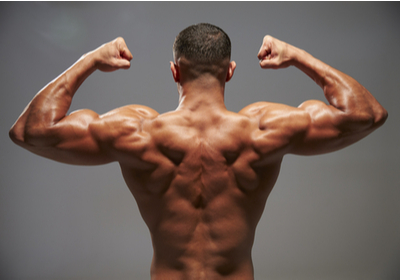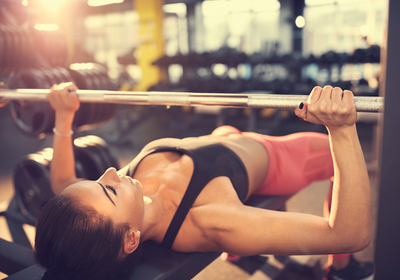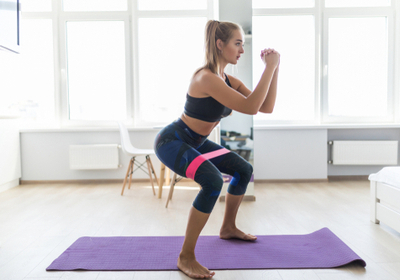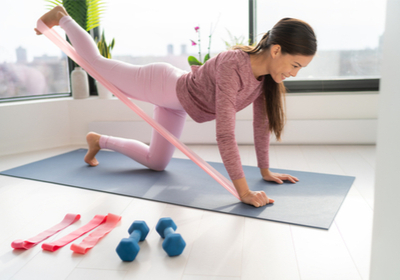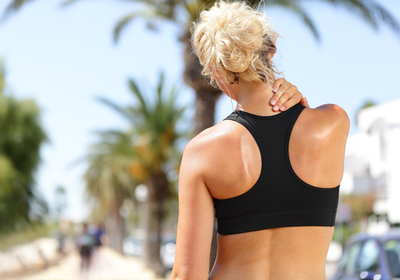VIDEO
RECOMMENDED FOR YOU
Plank Variation, Side Plank Variation, Mountain Climbers, Sit-Ups
- Core
- Arms
- Legs
Duaration: 00:15
save to playlist
Squat
- Gluteus
- Quads
- Hamstrings
Duaration: 00:29
save to playlist
Jump Squat Variation, Flutter Kicks, Squats, Alternating Side Lunge
- Biceps
- Trapezius
- Upper Back
Duaration: 00:15
save to playlist
Split Squat Press, Russian Twist with Weight, Triceps Kickback, Dumbbell Swing
- Abs
- Triceps
- Upper Back
Duaration: 00:15
save to playlist
Lunges, Side Squat, Plank to Squat Jump, Side Plank Variation, Pushups, Side Plank Hip Dips, Double Leg Lifts, Bicycle
- Core
- Arms
- Legs
Duaration: 00:15
save to playlist
Bench Jump Variation, Plank Crunches Variation, Mountain Climbers, Squat Jumps, Reverse Plank Knee Tuck Variation
- Core
- Arms
- Legs
Duaration: 00:15
save to playlist
Side Elbow Plank, Plank Jumping Jacks, Plank High Knee Lifts, Bridging, Bent Knee Leg Spreads
- Core
- Arms
- Legs
Duaration: 00:15
save to playlist
Reverse Crunches Variation, Russian Twists with Medicine Ball
- Core
- Legs
- Abs
Duaration: 00:15
save to playlist
Barbell Overhead Squat
- Core
- Biceps
- Upper Back
Duaration: 00:51
save to playlist
V-sit
- Back
- Abs
- Hamstrings
Duaration: 00:30
save to playlist
Bench Jump Over Hands Secured, Reverse Crunches, Plank Twisted Inner Leg Lifts, Side Plank Crunches
- Core
- Arms
- Legs
Duaration: 00:15
save to playlist
Barbell Sumo Deadlift
- Triceps
- Gluteus
- Quads
Duaration: 00:44
save to playlist
Mountain Climbers
- Core
- Shoulders
- Gluteus
Duaration: 00:30
save to playlist
Plank with Opposite Arm and Leg Lifts, Downward Facing Dog Variation, Crab Walk, Side Plank Variation
- Core
- Arms
- Back
Duaration: 00:15
save to playlist
Donkey Kicks, Plank Glute Kickback and Knee Draws
- Biceps
- Trapezius
- Shoulders
Duaration: 00:15
save to playlist
Lunge Variation, Side Lunge Variation
- Legs
- Gluteus
- Hips
Duaration: 00:15
save to playlist
Plank Shoulder Taps
- Back
- Abs
- Shoulders
Duaration: 00:28
save to playlist
Walking Squats, Jumps
- Legs
- Gluteus
- Hips
Duaration: 00:15
save to playlist
Shoulder Bridge
- Abs
- Upper Back
- Lower Back
Duaration: 00:15
save to playlist
Jumping Jacks Squat
- Gluteus
- Quads
- Hamstrings
Duaration: 00:15
save to playlist
Bounding
- Gluteus
- Quads
- Hamstrings
Duaration: 01:21
save to playlist
Bird Dogs
- Triceps
- Upper Back
- Shoulders
Duaration: 00:30
save to playlist
Side Squat Feet Touch
- Core
- Lower Back
- Obliques
Duaration: 00:20
save to playlist
Downward Dog to Knee Drive
- Back
- Abs
- Shoulders
Duaration: 00:20
save to playlist
Half Handstand Variation
- Core
- Arms
- Legs
Duaration: 00:15
save to playlist
Single Leg Squat, Standing Forward Bend Variation, Arm Pullover Straight Leg Crunch Variation
- Core
- Legs
- Abs
Duaration: 00:15
save to playlist
High Knees
- Gluteus
- Hamstrings
- Hips
Duaration: 00:30
save to playlist
Squat Jumps, Plank Jacks, ToeTouch Jump Squats, Plank Jumps
- Arms
- Legs
- Abs
Duaration: 00:15
save to playlist
Dumbbell Snatch
- Abs
- Wrists
- Biceps
Duaration: 01:02
save to playlist
Bird Dogs
- Core
- Upper Back
- Shoulders
Duaration: 00:58
save to playlist
Barbell Goodmornings
- Biceps
- Upper Back
- Shoulders
Duaration: 00:55
save to playlist
Barbell Clean and Press
- Core
- Biceps
- Upper Back
Duaration: 00:56
save to playlist
Pushups, Reverse Crunches, Double Leg Lifts, Dumbbells Squat
- Core
- Arms
- Back
Duaration: 00:15
save to playlist
Squat Side Kick, Lunge Hop, Forward Leg Swings, Donkey Kicks
- Core
- Back
- Biceps
Duaration: 00:13
save to playlist
Dumbbell Explosive Bulgarian Split Squat
- Biceps
- Upper Back
- Shoulders
Duaration: 00:49
save to playlist
Lunges
- Legs
- Gluteus
- Calves
Duaration: 00:32
save to playlist
One Legged Plank Variation
- Core
- Arms
- Legs
Duaration: 00:15
save to playlist
Wall Pushups, Wall Plank Variation
- Core
- Arms
- Back
Duaration: 00:15
save to playlist
Reverse Leg Lift
- Lower Back
- Gluteus
- Quads
Duaration: 00:16
save to playlist
Side Plank, Lunge Pulses, Side Plank Pulses, Squat Jump, Side Glute Raises
- Abs
- Biceps
- Upper Back
Duaration: 00:15
save to playlist
Blog
The trapezius is an extremely important muscle group that helps us to have a nice posture. Obviously, training these muscles is essential for every athlete and sports enthusiast. In this article, we are going to talk about the anatomy of the trapezius as well as how to build these muscles. So without any further ado, let us begin.
Anatomy of Trapezius
Trapezius and neck muscles are a part of the upper back and they consist of two layers. These muscles resemble a trapezoid, which is a geometry shape they had their name from. This muscle group can be divided into several parts, which are:
top
medium
bottom
Trapezius muscle symmetrically spreads to the side from the upper part of the vertebral column, imparting upward to the cervical vertebrae and to the back. The muscle fibers of the middle part of the trapezius are attached to the outer edges of the collarbones and scapular bones, and the fibers of the lower part are attached to the shoulder blades.
There are a lot of different functions of this muscle. In particular, the upper part of the trapezium is responsible for the rise of the shoulder as well as for the ability to raise arms. The lower part of the trapezius muscle is responsible for lowering the shoulders and arms. Finally, the middle trapezoidal zone assists in shoulder blade movement.
Peculiarities of Training
Since the functions of the various parts of the trapezius muscle are different, you need to perform a variety of exercises to train each of them. The middle and lower trapezius work well when the muscles of the back are in tension, therefore, any kind of pull-ups in the incline and weight lifting will work. For the upper part of the trapezius, you want to do exercises with dumbbells. The most important thing here is to be consistent in your training and you will no doubt see the results.
Exercises for Building Trapezius Muscles
Finally, let us take a brief look at some of the exercises for building these muscles. So here they come:
Shrug
Shoulder blade squeeze
Upright row
Chin-up
Push-up
Rear delt cable raise
Overhead farmer's walk
Rope rear delt pull
Y raise
High pulley cable row
Final Word
Trapezius muscles are very important for right posture and your back health, which is why no matter if you're a professional athlete or an office worker, you have to work on these muscles. So why don’t you start right now?
Read more
Chest muscles are among the hardest ones to train yet strengthening these muscles is totally possible. In this article, we are going to talk about chest muscles and how to train them.
How to Develop Chest Muscles
Developed chest muscles are a vivid indicator of hard work on the body. This muscle group is one of the largest and most complex in the human body. Complete training demands to combine basic and isolating exercises. This is the only way to build the muscles in perfect shape. Barbell exercises are more suitable for increasing muscle mass, and with dumbbells and equipment - for improving the shape and detailed work. It is a bad idea to use really heavyweights in the beginning. It’s much better to learn how to feel the work of the necessary muscles during working out your chest, your arms and shoulders. For example, classic push-ups from the floor will help you feel your chest muscles and understand how they work. For a proper workout, you need to use a variety of dumbbell chest exercises to work the muscles at different angles.
Workouts for Chest
Dumbbell bench pressPlace the dumbbells near your hands. Start by taking the correct position. The back of the head, back and pelvis are pressed to the bench. The heels are pressed into the floor, the legs are separated by 60 degrees. Memorize the position, sit down, grab the dumbbells, and put them on your knees. Lie down while getting the dumbbells to your chest. Extend your arms, leaving a slight angle at the elbow joint, keeping the dumbbells in parallel. Start the chest exercise with a smooth lowering of the weight, moving your elbows to the up and down. When you feel a stretch in your pectoral muscles, return your arms to their original position.
HammerStart it with the right position. Sit on the edge of a bench with the dumbbells on your knees. Lie down tightly pressing the back of your head, back, and lower back to the bench. At the same time, shift your weight from your hips to your chest. Raise your arms in front of you, keeping a 90-degree angle. The palms are turned towards each other, the elbows are slightly bent. Bend your arms as you inhale, bringing the dumbbells to your chest. During the exhalation, unbend focusing on the tension of the pectoral muscles. Repeat it. The Hammer adds extra tension to the triceps, so it's important to focus on your chest muscles. The exercise must be done slowly, and it requires concentrated work. It is great for beginners and athletes recovering from chest, shoulder, or elbow injuries.
Dumbbell PulloverLying on a bench, the back of the head, shoulders and buttocks are kept to the surface, the feet stand firmly on the floor, the hands hold the dumbbells on the chest line with one hand on the other. Fix it and raise the dumbbell over your head, doing a slight bend of the elbow. Exhaling, gently lower the dumbbell behind your head, focusing on stretching the pectoral muscles. Only the shoulders work in the process. Having reached the maximum tension in the lower amplitude, return your arms back along the same trajectory. This exercise with dumbbells on the chest is optional, therefore it is more logical to use it in the mix with basic exercises. It helps to stretch the chest muscles, as well as increase the shape of the chest. Make sure that the head is supported in this position. Otherwise, the risk of straining the cervical muscles or pinching the nerve becomes critical. Work the dumbbell smoothly, avoiding sudden jerks and extreme weights.Also don’t forget that some pre-workout warm-ups are great for increasing your stamina and recovery, but don't rely on them all the time. Getting the right amount of sleep and proper nutrition are two of the most important factors in increasing your gym performance.
Final Thoughts
Exercises for your chest will help you improve your relief as well as general health, so make sure to train these muscles at least a little bit while working out.
Read more
Everyone wants to have beautiful hips. Unfortunately, it's not that easy to keep it in a nice shape. We have some exercises that will definitely help you work your hips out.
Best Workouts for Hips
Beautiful hips require some effort, so let’s take a look at some exercises for hips.
CrossingsThis deep inner thigh stretch will improve your hips and give you a boost of energy. Spread your legs wide with your feet facing outward. Bend your knees and lower yourself into a squat. Put your hands on your hips just above the knees, deepening the squat and stretching even more. Jump up and place your right foot in front of your left one, while landing, you should straighten and cross your legs. Return to the starting position and repeat the exercise with the other leg. Repeat the exercise, alternating legs, as many times as you can, for at least 40 seconds.
Knee squatsSquats with knees together are much better than regular squats for strengthening the inner thighs, quads, and hamstring. And in order not to waste your time, you can work on your hands at the same time. Stand up straight with your feet together. Take dumbbells, bend your elbows and touch the shoulders with the dumbbells. Do a squat with your knees bent and your hips back as if you were about to sit in a chair. Keep your legs together during the entire exercise. The weight should be on your heels. Now stretch your arms up. Return to the starting position without putting your weight on your toes. Do 10 reps.
Elbow plank with raising legsAdd leg raises to your regular elbow plank to improve the hips. Lie on your side, bend your right arm at the elbow and lean on it. Extend your legs so that your body becomes one straight line. Try to rest only on the outer edge of your right foot. Place your left hand on your thigh. Feel your spine stretch and your abs tighten, then lift your left leg just above your hip. Slowly lower it back down. Do not bend at the waist or lean on your shoulder, keep your weight on your elbow. Do about 15 reps for both sides.
Swings with bent legsThis is one of the most popular exercises for strengthening the buttocks and hips. It is suitable for everyone, does not require additional equipment, and does not involve the spine. With the help of swings, the back, front, outer and inner thighs are worked out - combo. Start in plank, palms - under the shoulders, knees - under the pelvis, keep the position of the back. On the exhale, we swing our leg, pushing the heel up; we perform 20 repetitions on each leg and four sets total.
Side lungesIf you are doing this exercise for the first time, you will not need dumbbells - first master the movements of the legs. Take a dumbbell in your right hand, lunge to the left, lowering your right hand to your right leg. Lower your hips as low as possible, resting on your heels. The toes are facing forward, the angle of the bent leg is 90 degrees. Pushing off with your left foot, go into a courtesy pose: the left leg goes back, and the right one goes forward. Raise your arm with the weight up. Both legs face forward. Keep your hips and legs taut. Repeat without returning to the starting position, but immediately moving from a squat to a side lunge. Do three sets of 10 reps, then switch sides.
Final Word
Beautiful hips are a reality if you know what to do, so why don’t you give these exercises a try and see everything yourself?
Read more
The Kardashians set many beauty trends and one of those trends is gorgeous buttocks. So in this article, we will discuss how to build gluteus muscles and consequently look as hot as Kim, Kourtney, Khloé. Let’s start with the anatomy. The gluteus consists of three main parts:
Gluteus maximus muscle, which is the largest muscle of the body. It helps to maintain balance while walking and running, allows the leg to move outward, and it is also responsible for the tightened (or not so) shape of the buttocks.
The gluteus medius is partially overlapped by the gluteus maximus. It is located in the upper pelvis. It participates in the abduction of the leg to the side, lateral bending, and stabilization of the body during movement.
Finally, the gluteus minimus is located under the medius muscle. Together they are responsible for abducting the leg and stabilizing the body, as well as for forming the hip line.
Workouts for Gluteus
It's not that easy to build gluteus muscles, especially if you are limited in time. But if you work out at least three times a week and never give up, you will quickly reach your goal. In order to help you achieve your goal, we prepared the best exercises for developing muscles of the gluteal region. So here they come:
Barbell/dumbbell LungesThis exercise is ideal for those who are interested in pumping up the top of the buttocks and at the same time the back of the thigh. Begin the movement by bringing each leg one at a time forward. The thigh should be parallel to the floor and the knee should be at the right angle.
Barbell SquatThis is one of the basic exercises that help effectively build this muscle. From the starting position - legs apart, lower the pelvis just below the knees. Do not bend your lower back and make sure your knees do not surpass your feet. The wider your legs are apart, the greater the load on the buttocks.
Romanian deadliftsStand upright with your back slightly arched at the lower back. Holding the dumbbells in your hands, bend over, pulling your pelvis back. Once you reach the spot just below your knees, return to the starting position.
Dumbbell Split SquatsThe exercise is performed with a straight back, with one leg taking a step forward and throwing the other one on a stand from behind. Squat and do the exercise for both legs.
Back LungesStart in a standing position, take a wide step back and lower into a lunge. Return to the starting position and repeat the exercise for the other leg. Do 20-30 repetitions for each leg, making sure that your knees are bent at right angles and do not protrude beyond your toes. It is important to take steps exactly backward while maintaining rhythm and balance.
Wrapping Up
Gorgeous buttocks are everyone’s dream come true and, luckily, it’s not that difficult to develop these muscles if you know the right workouts. So why don’t you use our guides and start moving toward your goal now?
Read more
Many athletes as well as sports enthusiasts focus on the workouts for the middle and lower back and ignore upper back exercises, which can lead to a number of negative consequences such as a slower rate of progression or even curvature of posture and muscle imbalance. Correctly selected load and good upper back exercises will help you effectively work out the desired area and, as a result, have a gorgeous body. So let’s talk about building upper back muscles.
Anatomy and Function of the Muscles of the Upper Back
Anatomically, the muscles of the upper back are represented by the two large areas, which are the trapezius and latissimus muscles. In addition to that, the back bundles of deltas are often referred to as the upper back, as they are involved in most exercises. But from the anatomical point of view, it is incorrect.
The trapezius muscles are responsible for the movement of the shoulder blades. They are attached to the back of the head at the top and to the spine at the bottom. These muscles are extremely important for posture and keeping the back straight. The latissimus muscles occupy almost the entire back area and are located on both sides of the spine. Latissimus muscles resemble wings in shape. It is important to understand that the upper back refers only to the part of the lats, which is located under the trapezium. The main function of these muscles is to bring the shoulder to the body and pull the arm back.
Peculiarities of Training
Even if your upper back is slightly undeveloped, you should not try to build this area by increasing the volume of loads. Such training will rather lead to hypertonicity of the trapezium and problems with the cervical spine than to beneficial muscle strengthening. Try to use no more than 2-3 upper body exercises per workout or put the same load on each part of the back, this will help “tighten” the lagging top without muscle imbalance. It is also recommended to alternate power and repetition modes (in micro-cycles or cycles). This will help to create the most versatile load, as well as balance the ratio of fast and slow muscle fibers, which is genetically set for each person. Finally, while training in the gym, make sure your exercises are diverse as well as focus on different parts of the upper back. If you prefer to exercise at home, do various exercises with dumbbells. You might also want to try rubber band workouts.
Workouts for Upper Back
Last, but not least, let’s have a quick look at some useful exercises for the upper back:
Reverse Fly
Barbell High Rows
T-Pulls
Upright Row
Y-Pulls
Seated Row
Renegade Row
Final Thoughts
Upper back muscles are very important for the right posture and general back health, which is why you should include some exercises for this muscle group in your workout routine. Find out lots of beneficial upper back exercises in our video tutorials.
Read more
SAVE TO ...

